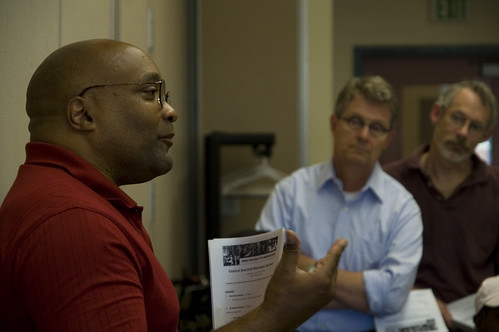
The Miller Park community center played host to the “second chance” neighborhood planning gathering Thursday night for the Pike/Pine, Central Area, and Capitol Hill Neighborhoods.
About 40 people attended, with a majority coming from the central district, to discuss and gain community feedback on the 10-year-old neighborhood plans. This meeting was a special effort to confirm the community’s involvement, but David Goldberg from DPD explained that this is only a step to a plan update, as only a few neighborhood plans will qualify under the undetermined criteria for updating.
Those of you who took the city’s online neighborhood survey might recognize those — they’re the same questions the city asked on the Internet.
For Central Area, the immediate concern was the clumping of three different urban villages, Madison-Miller, 12th Ave., and 23rd & Union Jackson, despite differences in opinion within those communities and the separation of Pike/Pine from Capitol hill. While not complete, here is a summary of what was said at the meeting at the Central Area table lead by Adrienne Bailey.
- Increase in number of people in the community.
- Different demographic.
- Decrease in facilities per person.
- Housing that doesn’t attract a diverse cultures.
- The need for addressing green building.
- Rent difficulties for small businesses competing with “big box stores”
- “Slapping a name on a park is an insult not an attribute.” No historical explanation or relevance behind the names on city parks.
- Lack of marketing to minorities (African Americans, Asians, Jewish) to come back to the Central Area.
- Lack of local, small businesses. Again, being priced out by big buisness.
- No investments in the community: Resturants, dry cleaners…all services that you can come and leave with.
- Central Area is not a destination for people outside of the neigborhood to come and spend time/money.
- School closures.
- Commercial side (ie. Safeway housing on madison) worked, Pedestrian part failed.
- No center in 23rd & Jackson or 23rd and Union when they were supposed to both be “hubs”.
- Supposed to be a transportation hub…no light rail.
- Need data on: How people commute to work. Family information.
- Families aren’t going to pick our neighborhood if there is nothing for their kids to do.
- Implementation of the plan: how will changes come about, who is going to do it, how long will it take?
- The need for different urban villages to ban together?
- Concern with distribution of information Internet vs. paper.

Well done.
” ‘Slapping a name on a park is an insult not an attribute.’ No historical explanation or relevance behind the names on city parks.”
This is the sort of “community input” that really drives me batty: The City does its part by establishing and maintaining a park, and giving it a name that the community requests. Why can’t the community come forward, by means of a Rotary or Kiwanis, or school kids, or tip jars in bars – as has been done for decades – and provide a commemorative plaque? Why does/should the city do it all? Why are we so passive?
For precedent, let’s look at Volunteer Park and its various memorials: I lift the following directly from the Seattle Parks Department website. ( http://www.seattle.gov/parks/park_detail.asp?ID=399)
Volunteer Monument
The granite boulder was erected in 1952, promoted by J. Willis Sayre, editor, concert and theatre manager, historian and veteran, through the United Spanish War Veterans (designed by Cassius Beardsley).
Seward Sculpture and pedestal
…….Sculpture financed by public subscription, sponsored by GG Beninghauser (jeweler), Meany, McGraw, et al.
Burke Monument
Dedicated in 1930 to honor pioneer Judge Thomas Burke (1849-1925) …… memorial contributed by admirers of Judge Burke.
“Block” Playsculpture
Honors Dorothy W. Block (1926-1961) ……. Sculpture sponsored by Block foundation.
You’ll notice all these tributes were provided by outside parties and given to the park. These people and organization didn’t expect the City to provide “historical explanation or relevance”.
If you want to be proud of your parks, and of their heritage, you have to do more than just agitate for a name and then sit back and complain when nobody knows who you are honoring. Having a community means maintaining that community, and leaving tributes for future generations.